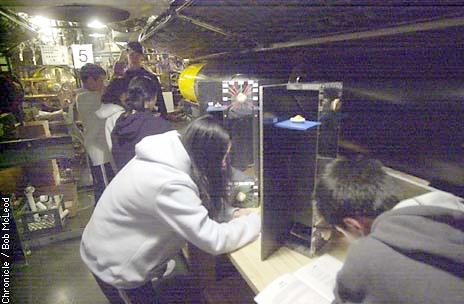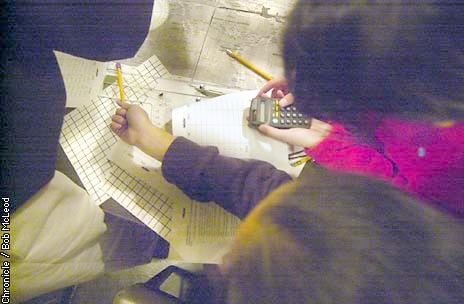| Return
Submarine nights Field trip teaches real science -- and middle schoolers are all aboard David Perlman, Chronicle Science Editor Saturday, November 30, 2002 Copied from San Francisco Chronicle. URL: http://sfgate.com/cgi-bin/article.cgi?f=/c/a/2002/11/30/BA159150.DTL Garbed in white, with their eyes protected by laboratory goggles and with a warning to take care with the chlorine and the copper, a team of eighth- graders from Visitacion Valley Middle School was building batteries the other night to turn a submarine's propeller, sound the alarm and light a single winking bulb. Their sub was only a foot-long model, but the students were working hard aboard a real one -- the Pampanito, which saw deadly service in World War II and is now a floating museum plus part-time science school at Pier 45 in San Francisco.
Visitacion Valley
students work on periscopes aboard the Pampanito, a museum "Hey, this battery's really working," said Paulina Wong, 13, with a delighted laugh as she and 13-year-old Xiu Xiu Huang labored together learning with their own hands the reality of electrical energy and how to generate and apply it. "It's just the way Thomas Edison did it too," math teacher Nicholas Louros reminded them. The battery project was just one of five that 29 eighth-graders from Visitacion Valley undertook during a recent adventure that combined an overnight field trip with hands-on science experience, financed by San Francisco's Maritime Park Association. And if hoisting their sleeping bags onto the Pampanito's three-tiered bunks in the crew's cramped quarters meant a night of carefully chaperoned giggling, squealing and maybe sleeping -- plus a couple of underwater movies -- it was also a genuine learning adventure. In the course of the evening the kids carefully recorded the results of their "experiments" probing such varied fields of applied research as optics, chemistry, acoustics, energy, navigation, buoyancy and, of course, mathematics. They took turns on the Pampanito's conning tower, and, peering through its periscope in the well below to understand the optical angles needed to see around corners, they fashioned their own working periscopes with plastic tubing, mirrors and tape. The things really worked. "Wow!" said Johnson Wong. "Cool!" said Jiayu Cheng. They heard the pinging of a ship's sonar as it bounced sound waves off a simulated deep-sea floor and learned how trained ears can tell the difference between the signal from a whale diving or a ship's propellers spinning.
Navigation charts
for fantasy expeditions teach math and science After a quick onboard course in codes and navigation, they charted their own voyage across thousands of miles of the Pacific from the Philippines to Honolulu and home, calculating time, speed and distance and learning the uses of latitude and longitude. With plastic bottles, a tank of water, a few metal washers and thin plastic tubes, the students worked in teams to study what whales know instinctively and submarine crews are rigorously trained to know: They learned the three types of buoyancy -- positive, neutral and negative. In effect, the kids turned their plastic bottles into submarines, and by blowing or sucking air out of their bottles, they made them rise, sink, or remain suspended in mid- ocean, just as submarines and whales can do. This was the second year that students from the Visitacion Valley school were able to do science aboard the Pampanito, and to Liz Abrahams, their science teacher, the experience has been a huge success. "The last group is still raving about it," Abrahams said after a nearly sleepless night aboard. "I'm a very hands-on kind of teacher, and I don't think the kids will ever forget the night they spent or the lessons they learned." Every one of the school's 186 eighth-graders wants to do the Pampanito thing, but Abrahams must limit each session to 30. So the students earn the coveted night by their records of volunteering for community service -- like cleaning up the neighborhood, or helping younger kids at school, or joining coastal cleanup groups. Early next year, Abrahams -- with the help of parents and the Pampanito's staff -- will bring 30 sixth- and seventh-graders to the submarine, and this time the ones who have just finished their overnight fun will act as mentors before the newcomers begin. "Last night's kids will be teachers in the classroom themselves," Abrahams said. The Pampanito has run these overnight science schools for only two years, but word of their success is spreading. A school like Visitacion Valley serves an extremely low-income area of San Francisco and depends on the Maritime Park Association's scholarship money to pay each session's modest expenses. Private schools, however, pay their own way, and although the coming nights in January are being booked already, a few nights are still open. With a staff of professionals and volunteers, the association runs several other school programs besides the Pampanito, including several on the historic sailing ship C.A. Thayer at the Hyde Street Pier. There are overnight stays as crew members aboard the Thayer, hands-on history lessons on the Gold Rush and the Barbary Coast, and working voyages under sail on the Bay. Information is available on the Web at http://www.maritime.org/nmmaedu1.htm E-mail David Perlman at dperlman@sfchronicle.com ©2002 San Francisco Chronicle. Page A - 19 |

